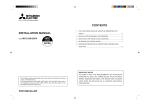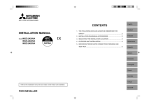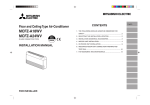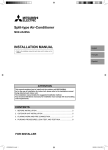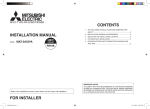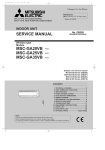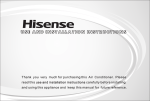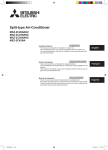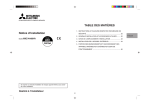Download INSTALLATION MANUAL CONTENTS
Transcript
SPLIT-TYPE AIR CONDITIONER CONTENTS 1. THE FOLLOWING SHOULD ALWAYS BE OBSERVED FOR INSTALLATION MANUAL MXZ-A18WV HFC utilized R410A Deutsch SAFETY ........................................................................................... 2 2. INSTALLATION DIAGRAM & ACCESSORIES ................................ 2 Model English Français 3. SELECTING THE INSTALLATION LOCATION ................................ 3 4. OUTDOOR UNIT INSTALLATION ................................................... 4 Nederlands 5. INDOOR/OUTDOOR UNITS CONNECTION FINISHING AND TEST RUN ....................................................................................... 5 Español Italiano ∂ÏÏËÓÈο Português Dansk Svenska Türkçe Русский FOR INSTALLER 1. THE FOLLOWING SHOULD ALWAYS BE OBSERVED FOR SAFETY 2. INSTALLATION DIAGRAM & ACCESSORIES • Please provide an exclusive circuit for the air conditioner and make sure that no other electrical appliances are connected to it. • Be sure to read “THE FOLLOWING SHOULD ALWAYS BE OBSERVED FOR SAFETY” before installing the air conditioner. • Be sure to observe the cautions specified here as they include important items related to safety. • The indications and meanings are as follows. WARNING: Could lead to death, serious injury, etc. CAUTION: Could lead to serious injury in particular environments when operated incorrectly. • After reading this manual, be sure to keep it together with the OPERATING INSTRUCTIONS in a handy place on the customer’s site. Before installation This installation manual is only for the outdoor unit installation. In installing the indoor units, refer to the installation manual attached to each indoor unit. Any structual alternations necessary for the installation must comply with the local building code requirements. WARNING ■ Do not install the unit by yourself (customer). Incomplete installation could cause injury due to fire, electric shock, the unit falling or leakage of water. Consult the dealer from whom you purchased the unit or special installer. ■ Install the unit securely in a place which can bear the weight of the unit. When installed in an insufficient strong place, the unit could fall causing injury. ■ Use the specified wires to connect the indoor and outdoor units securely and attach the wires firmly to the terminal block connecting sections so the stress of the wires is not applied to the sections. Incomplete connecting and fixing could cause fire. ■ Do not use intermediate connection of the power cord or the extension cord and do not connect many devices to one AC outlet. It could cause a fire or an electric shock due to defective contact, defective insulation, exceeding the permissible current, etc. ■ Check that the refrigerant gas due not leak after installation has completed. If refrigerant gas leaks indoors, and comes into contact with the fire of a fan heater, space heater, stove, etc., harmful substances will be generated. ■ Perform the installation securely referring to the installation manual. Incomplete installation could cause a personal injury due to fire, electric shock, the unit falling or leakage of water. ■ Perform electrical work according to the installation manual and be sure to use an exclusive circuit. If the capacity of the power circuit is insufficient or there is insufficient electrical work, it could result in a fire or an electric shock. ■ Attach the electrical cover to the indoor unit and the service panel to the outdoor unit securely. If the electrical cover in the indoor unit and/or the service panel in the outdoor unit are not attached securely, it could result in a fire or an electric shock due to dust water, etc. ■ Be sure to use the part provided or specified parts for the installation work. The use of defective parts could cause an injury due to a fire, an electric shock, the unit falling, leakage of water, etc. ■ Be sure to cut off the main power in case of setting up the indoor electronic control P.C. board or wiring works. It could cause an electric shock. ■ The appliance shall be installed in accordance with national wiring regulations. K H I E J Open as a rule More than 100 mm if the front and both sides are open * More than 100 mm More than 100 mm F A 200 mm or more if there are obstacles to both sides B CAUTION ■ Perform earthing. Do not connect the earth wire to a gas pipe, water pipe, lightning rod or telephone earth wire. Defective earthing could cause an electric shock. ■ Do not install the unit in a place where an inflammable gas leaks. If gas leak and accumulate in the area surrounding the unit, it could cause an explosion. ■ Fasten a flare nut with a torque wrench as specified in this manual. D When fastened too tight, a flare nut may broken after a long period and cause a leakage of refrigerant. ■ Install a earth leakage breaker depending on the installation place (Where it is humid). If a earth leakage breaker is not installed, it could cause an electric shock. ■ Perform the drainage/piping work securely according to the installation manual. If there is a defect in the drainage/piping work, water could drop from the unit and household goods could be wet and damaged. C Open as a rule More than 200 mm if the back, both sides and top are open More than 350 mm * Note: The dimensions given along the arrows above are required to guarantee the air conditioner’s performance. Install the unit in as wide a place as possible for later service or repairs. 2 3. SELECTING THE INSTALLATION LOCATION Parts to be locally procured ACCESSORIES Check the following parts before to installation. <Outdoor unit> 1 2 Drain socket Drain cap A 1 2 B C D E F G H I J K L • • • • • • • • Where it is not exposed to strong wind. Where airflow is good and dustless. Where it is not exposed to rain and direct sunshine. Where neighbours are not annoyed by operation sound or hot air. Where rigid wall or support is available to prevent the increase of operation sound or vibration. Where there is no risk of combustible gas leakage. When installing the unit at a high level, be sure to fix the unit legs. Where it is at least 3 m away from the antenna of TV set or radio. (Otherwise images would be disturbed or noise would be generated.) • Install the unit at level. Power supply cord 1 (3-core 2.5 mm2) Indoor/outdoor unit connecting wire 1 (2-core 1.0 mm2/1.5 mm2) Extension pipe According to “Selecting pipe size” 1 Wall hole cover 1 Piping tape 1 Extension drain hose (or soft vinyl chloride hose of 1 15 mm in internal dia. or hard vinyl chloride pipe VP16) Refrigeration oil Little amount Putty 1 Pipe fixing band 2 to 7 (The number depends on the pipe length.) Fixing screw for I 2 to 7 (The number depends on the pipe length.) Wall hole sleeve 1 Soft vinyl chloride hose of 25 mm in internal 1 dia. or hard vinyl chloride pipe VP25 Note: It is advisable to make a piping loop near outdoor unit so as to reduce vibration transmitted from there. WARNING: Be sure to install the unit in a place that well sustains its weight. Installing in a place with less strength may result in a unit falling, causing a risk of injury. CAUTION: Avoid the following places for installation where air conditioner trouble is liable to occur. • Where flammable gas could leak. 4-Oval holes (10 × 21) • Where there is much machine oil. • Salty places such as the seaside. • Where sulfide gas is generated such as a hot spring. • Where there is high-frequency or wireless equipment. Note: Do not use the drain socket and the drain cap in the cold region. Drain may freeze and it makes the fan stop. • The “Q’ty” for B to K in the above table is the quantity to be used per indoor unit. WARNING: Be sure to use specified accessories and supplied parts for installation work. If there is some deficiency in parts, it may cause a risk of fire, electric shock, injury by a unit fall or water leakage. (Unit: mm) Constraints On Indoor Unit Installation You should note that indoor unit that can be connected to this outdoor unit have the following constraints on them. • Refer to the table below for possible two-room indoor unit combinations. Window • When installing the unit in an area that is enclosed on four sides such as a verandah, be sure to leave move than 200 mm behind the unit as shown. • When there is a lack of airflow or there is a possibility of becoming short cycle, install an outlet guide and make sure there is enough space behind the rear side of the air inlet. Combination (Models) · · · · 6 combinations possible MSC-07+MSC-07 MSC-07+MSC-09 MSC-07+MSC-12 MSC-09+MSC-09 MSC-09+MSC-12 MSC-12+MSC-12 More than 200 mm More than 100 mm More than 200 mm Less than 1,200 mm of the front surface side Note: Make sure not to install several outdoor units sideways next to each other. 3 More than 200 mm More than 350 mm 4. OUTDOOR UNIT INSTALLATION 4-1 INSTALLING THE UNIT 4-3 • Be sure to fix the unit’s legs with bolts when installing it. • Be sure to install the unit firmly to ensure that it does not fall by an earthquake or a gust. • Refer to the figure in the right for concrete foundation. 4-2 INDOOR/OUTDOOR WIRE CONNECTION AND OUTDOOR POWER SUPPLY CORD CONNECTION • Be sure to lead in the power supply cord A to the air conditioner in accordance with the specification table below and “Technical Standards for Electrical Installation”. • Be sure to use special circuits for room air conditioner. MOUNTING ARRANGEMENT OF DRAIN SOCKET CAUTION: Attach an earth leakage breaker according to your installation location. If any breaker is not attached, it may cause a risk of electric shock. Please perform the drain piping work only when draining from one place. CAUTION: Do not insert drain socket and drain cap in the cold region because of drain freezing and fan stop. WARNING: Be sure to comply with “Technical Standards for Electrical Installation”, follow this manual and use special circuits for electrical work. If there is a lack of circuit capacity or some deficiency in installation, it may cause a risk of fire or electric shock. Overcurrent that might be produced may include DC substances. Be careful to choose the correct type of overcurrent protection switch. 1 Please choose one hole to which drain is drained, and install the drain socket in the hole. 2 Please close the hole of the remainder with the drain cap. 3 Please connect a vinyl hose of 25 mm in the inside diameter on the market with the drain socket and lead drain. Rated Voltage 230 V Breaker capacity 20 A Connect to the supply terminals and leave a contact separation of at least 3 mm at each pole to disconnect the source power pole. (When the power switch is shut off, it must disconnect all poles.) • Peel off both ends of the cables as shown in the right. • Take care not to let the cables contact the pipes inside the unit. • Take enough care to connect the indoor/outdoor unit connecting wire correctly between the respective indoor units and the outdoor unit. 15 mm 35 mm • For the power supply cord and the indoor/outdoor unit connecting wires, be sure to use the ones in compliance with the standards. • Be sure to push the core until it is hidden and pull each cable to make sure that it is not pulled up incomplete insertion may cause a risk of burning the terminal blocks. Power supply cord Specification Indoor and Outdoor connecting wire Specification Cable 3-core 2.5 mm2, in conformity with Design 245 IEC 57. Cable 2-core 1.0/1.5 mm2, in conformity with Design 245 IEC 57. This installation manual is only for the outdoor unit installation. In installing the indoor units, refer to the installation manual attached to each indoor unit. <OUTDOOR UNIT> ı UNIT Å UNIT Indoor/outdoor unit connecting wire ı UNIT 3 Refer to the figure below. Terminal block N L 3 3 N GROUND N 2 1 N L POWER SUPPLY ~/N 230V 50Hz Power supply cord Å UNIT 4 5. INDOOR/OUTDOOR UNITS CONNECTION FINISHING AND TEST RUN 1 Remove the service panel. 2 Remove fixing screw of terminal cover. 3 Connect the indoor/outdoor wire and power supply cable to the terminal block. 4 Replace the terminal cover securely. 5-1 PIPE LENGTH AND HEIGHT DIFFERENCE Limits Pipe length per indoor unit Total pipe length for multi-system Height difference No. of bends per indoor unit Total No. of bends for multi-system Cable clamp Terminal cover Route the indoor/outdoor connecting wire B and the power supply cord A along with the unit. Firmly tighten the indoor/outdoor connecting wire B and the power supply cord A. } } FLARED CONNECTIONS 20 m 30 m 10 m 15 30 max. max. max. max. max. Refrigerant adjustment ....... If pipe length exceeds 20 m, additional refrigerant (R410A) charge is required. (The outdoor unit is charged with refrigerant for total pipe length up to 20 m.) Power supply cord A Up to 20 m ı unit Pipe length Å unit Refrigerant to be added Be sure that the indoor/outdoor connecting wire B does not contact the stop valve. No additional charge is required. Additional charge is required. (Refer to the table below.) 20 g/m × (refrigerant piping length(m)-20) Exceeding 20 m Since the outdoor unit for this model has refrigerant filled for connection pipes, do not fill any additional refrigerant. Do not also exceed the allowable length of pipes given in the table above in piping work. Indoor unit WARNING: • Be sure to attach the service panel of the outdoor unit securely, otherwise it may result in a fire or an electric shock from dust or water. • Use the indoor/outdoor unit connecting wire that meets the Standards to connect the indoor and outdoor units and fix the wire to the terminal block securely so that no external force is conveyed to the connecting section of the terminal block. Incomplete connection or fixing of the wire could result in a fire. • Be sure to attach the terminal block cover on the both indoor and outdoor units. If the terminal block cover is incorrectly attached, it may cause a risk of fire or electric shock due to dust or water penetration. ı UNIT Outdoor unit Indoor unit Å UNIT • For pipe size, see the table below. SELECTING PIPE SIZE The diameter of connection pipes differs according to the type and capacity of indoor units. Match the diameters of connection pipes for indoor and outdoor units according to the following table. Model name MSC-07 MSC-09 MSC-12 Pipe size for indoor unit Liquid pipe Gas pipe Liquid pipe Gas pipe ø6.35 mm ø9.52 mm ø6.35 mm ø12.7 mm Allowable connection pipe size ø6.35 mm ø9.52 mm ø6.35 mm ø12.7 mm Valve size for outdoor unit Å UNIT ı UNIT Liquid pipe Gas pipe Liquid pipe Gas pipe ø6.35 mm ø9.52 mm ø6.35 mm ø9.52 mm • If the diameter of connection pipes does not match the diameter of pipe end connections, use optional different-diameter joints. • When connecting the model MSC-A12 to either outdoor unit A or B, use optional different-diameter joints (MAC-A454JP) because the valve size of gas pipes for the outdoor unit is ø9.52 mm. 5 PIPING PREPARATION 1 If you use commercially available copper pipes, use the following table for pipe specifications. Liquid pipe Gas pipe Gas pipe Outside diameter ø6.35 mm ø9.52 mm ø12.7 mm • Perform flaring work using flaring tool as shown in the right. Wall thickness 0.8 mm 0.8 mm 1.0 mm Outside diameter Flare tool for R410A clutch type ø6.35 mm 0 to 0.5 ø9.52 mm 0 to 0.5 ø12.7 mm 0 to 0.5 2 For insulation material, use 8 mm-thick heat-insulating expended polyethylene with a specific grarity of 0.045. 3 Ensure that the 2 refrigerant pipes are insulated to prevent condensation. 4 Refrigerant pipe bending radius must be 100 mm or more. A (mm) Conventional flare tool Clutch type Wing nut type 1.0 to 1.5 1.5 to 2.0 1.0 to 1.5 1.5 to 2.0 1.0 to 1.5 2.0 to 2.5 Clutch type Wing nut type A York Firmly hold copper pipe in a die in the dimension shown in the table above. CAUTION: Be sure to use the insulation of specified thickness. Excessive thickness may cause incorrect installation of the indoor unit and lack of thickness may cause dew drippage. 5-2 Flaring tool 4. Flaring work Die Die Copper pipe 5. Check Flare nut • Compare the flared work with the figure below. • If flare is noted to be defective, cut off the flared section and perform flaring work again. Smooth all around Copper pipe Inside is shining without any scratches FLARING WORK • Main cause of gas leakage is defect in flaring work. Perform flaring work correctly in the following procedure. Even length all around No good 1. Pipe cutting Good Copper pipe 90° 5-3 Tilted Uneven Burred PIPE CONNECTION Note: Fasten a flare nut with a torque wrench as specified in the table below. When fastened too tight, a flare nut may broken after a long period and cause a leakage of refrigerant. • Cut the copper pipe correctly with pipe cutter. 2. Burrs removal • Completely remove all burrs from the cut cross section of the pipe. • Put the end of the copper pipe downward to prevent burrs from dropping in the pipe. 3. Putting nut on • Remove flare nuts attached to indoor and outdoor units, then put them on pipe having completed burr removal. (not possible to put them on after flaring work) Burr 1. Indoor unit connection • Connect both liquid pipe and gas pipe to indoor unit. - Apply a thin coat of refrigeration oil to the seat surface of pipe. - For connection, align the center of both pipe and union, then tighten the first 3 to 4 turns in flare nut by hand. - For tightening the union part of the indoor unit side, use the table below as a standard and tighten the flare nut with two wrenches. Excessive tightening damages the flared section. Copper pipe Spare reamer Pipe cutter Flare nut Pipe diamete Copper pipe ø6.35 mm ø9.52 mm ø12.7 mm Tightening torque N·m kgf·cm 13.7 to 17.7 140 to 180 34.3 to 41.2 350 to 420 49.0 to 56.4 500 to 575 2. Outdoor unit connection • Connect pipes to the pipe joint part of the stop valve in the same method as the indoor unit. - For tightening, use the same tightening torque applied for indoor unit and tighten the flare nut with torque wrench or spanner. INSULATION AND TAPING 1 Cover piping joints with pipe cover. 2 For outdoor unit side, surely insulate every piping including valves. 3 Using piping tape E, apply taping starting from the entry of outdoor unit. • Fix the end of piping tape E with adhesive tape. • When piping has to be arranged through above ceiling, closet or area where the temperature and humidity are high, wind additional commercially sold insulation for prevention of condensation. 6 5-4 WARNING: When installing or moving the unit, do not mix anything other than specified refrigerant (R22) into the refrigerating cycle. If air is mixed, it may cause the refrigerating cycle to get abnormally high temperature, causing a risk of burst. PURGING PROCEDURES·LEAK TEST • Perform the manifold valve work securely according to the installation manual of the manifold valve. • Perform the purging work on both unit Å and unit ı. PURGING PROCEDURES Connect the refrigerant pipes (both liquid pipe and gas pipe) between the indoor and the outdoor unit. Cap for service port Cap for stop valve Remove the service port cap of the stop valve on the gas pipe side of the outdoor unit. (The stop valve will not work in it initial state fresh out of the factory [totally closed with cap on].) 5-5 CAUTION: Do not connect the earth cable to any gas pipe, water pipe, lightening rod or telephone earth cable. If there is some deficiency in earthing work, it may cause a risk of electric shock. Run the vacuum pump. (Vacuumize for more than 15 minutes.) Check the vacuum with the gauge manifold valve, then close the gauge manifold valve and stop the vacuum pump. The product incorporates a frequency inverter and so requires earthing in order to observe electric charge and noise caused by static electricity. Leave it as is for one or two minutes. Make sure the pointer of the gauge manifold valve remains in the same position. Confirm that the pressure gauge shows –0.101 MPa [Gauge] (–760 mmHg). Hexagonal wrench Open Close 5-6 Compound pressure -0.101MPa ı unit side Stop valve (-760 mmHg) gauge (for R410A) Pressure gauge Service port (for R410A) Liquid pipe Gauge manifold valve (for R410A) Gas pipe Handle High Handle Low Charge hose Cap (for R410A) Stop valve (or the vacuum Vacuum pump pump with the Window function to Charge hose Adapter for prevent the (for R410A) preventing back flow) the back flow CHECKING AFTER INSTALLATION After finishing the installation, check the following items again by making . Have special circuits been provided? Is power supply voltage as specified? Has indoor/outdoor connecting wire been inserted into terminal block? Has indoor/outdoor connecting wire been secured firmly? Has intermediary connection between power cable and indoor/outdoor connecting wire been carried out? Is combination of connection pipes and indoor/outdoor connecting wire correct (Room A, Room B)? Is earth cable connection correct? Has leak test been carried out? Has air purge been carried out? Is stop valve fully open? Has drain discharge been checked? Is insulation over connection pipe joints correct? Is strength of installation location well enough? Have all of WARNING and CAUTION items in “1. THE FOLLOWING SHOULD ALWAYS BE OBSERVED FOR SAFETY” been checked? Remove the gauge manifold valve quickly from the service port of the stop valve. After refrigerant pipes are connected and evacuated, fully open all stop valves on both sides of gas pipe and liquid pipe. Operating without fully opening lowers the performance and this causes trouble. Pipe length up to 20 m No gas charge is needed. EARTHING WORK Put the earth circuit to the ground in accordance with “Technical Standards for Electrical Installation”. Connect the gauge manifold valve and the vacuum pump to the service port of the stop valve on the gas pipe side of the outdoor unit. Stop valve Tightening torque N·m kgf·cm 13.7 to 17.7 140 to 180 19.6 to 29.4 200 to 300 Pipe length exceeding 20 m Charge the prescribed amount of gas. (refer to 5-1) Tighten the cap to the service port to obtain the initial status. Retighten the cap. Leak test 7 5-7 GAS CHARGE Perform gas charge to unit Å or ı. 1 Connect gas cylinder to the service port of stop valve. 2 Perform air purge of the pipe (or hose) coming from refrigerant gas cylinder. 3 Replenish specified amount of the refrigerant, while operating the air conditioner for cooling. Note: In case of adding refrigerant, comply with the quantify specified for the refrigerating cycle. CAUTION: For additional charging, charge the refrigerant from liquid phase of the gas cylinder. If the refrigerant is charged from the gas phase, composition change may occur in the refrigerant inside the cylinder and the outdoor unit. In this case, ability of the refrigerating cycle decreases or normal operation can be impossible. However, charging the liquid refrigerant all at once may cause the compressor to be locked. Thus, charge the refrigerant slowly. To maintain the high pressure of the gas cylinder, warm the gas cylinder with warm water (under 40°C) during cold season. But never use naked fire or steam. Union Indoor unit Stop valve Liquid pipe Gas pipe Union Indoor unit Liquid pipe Outdoor unit Gas pipe Refrigerant gas cylinder operating valve (for R410A) Service port Gauge manifold valve (for R410A) Charge hose (forR410A) Refrigerant gas cylinder for R410A with siphon Refrigerant (liquid) Electronic scale for refrigerant charging 8 This product is designed and intended for use in the residential, commercial and light-industrial environment. The product at hand is based on the following EU regulations: • Low Voltage Directive 73/23/ EEC • Electromagnetic Compatibility Directive 89/336/ EEC HEAD OFFICE: MITSUBISHI DENKI BLDG., 2-2-3, MARUNOUCHI, CHIYODA-KU, TOKYO 100-8310, JAPAN SG79Y048H01









